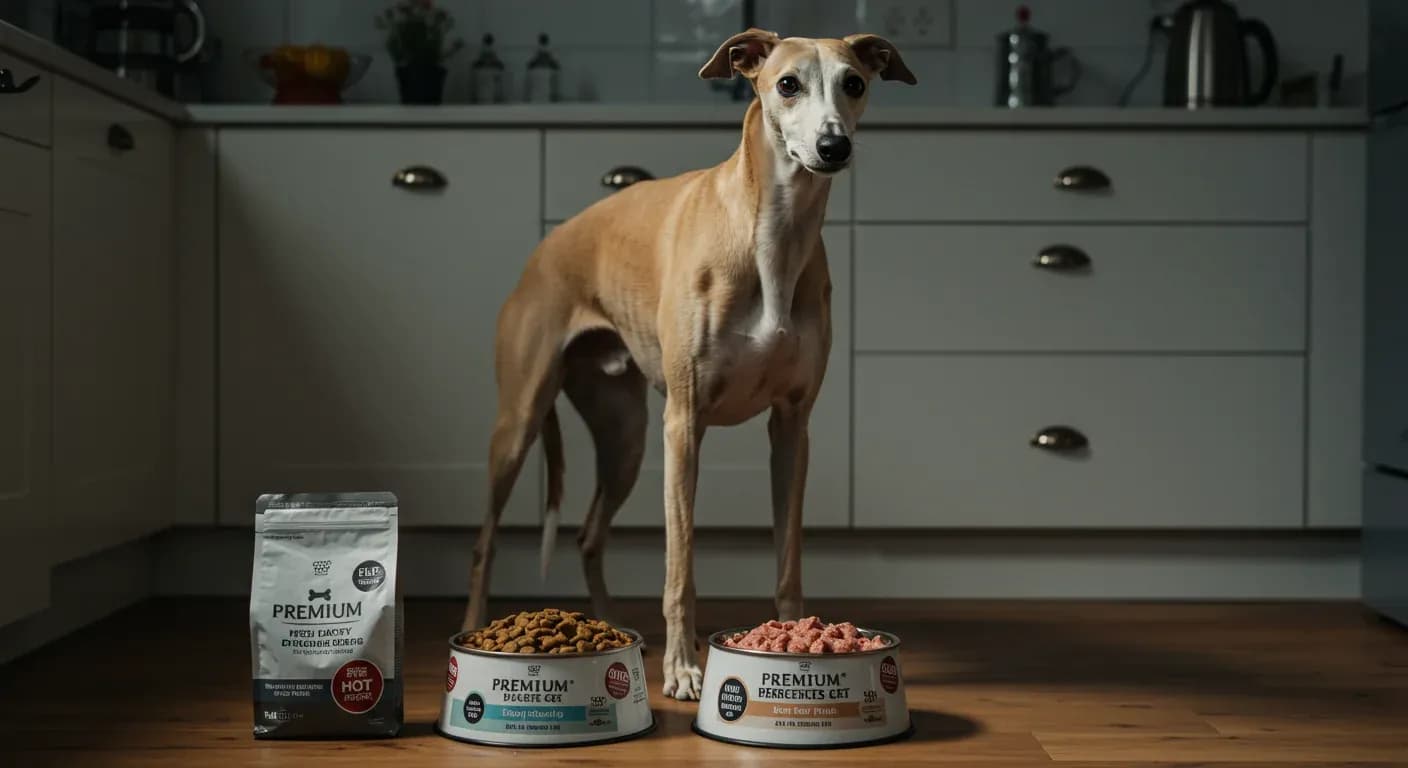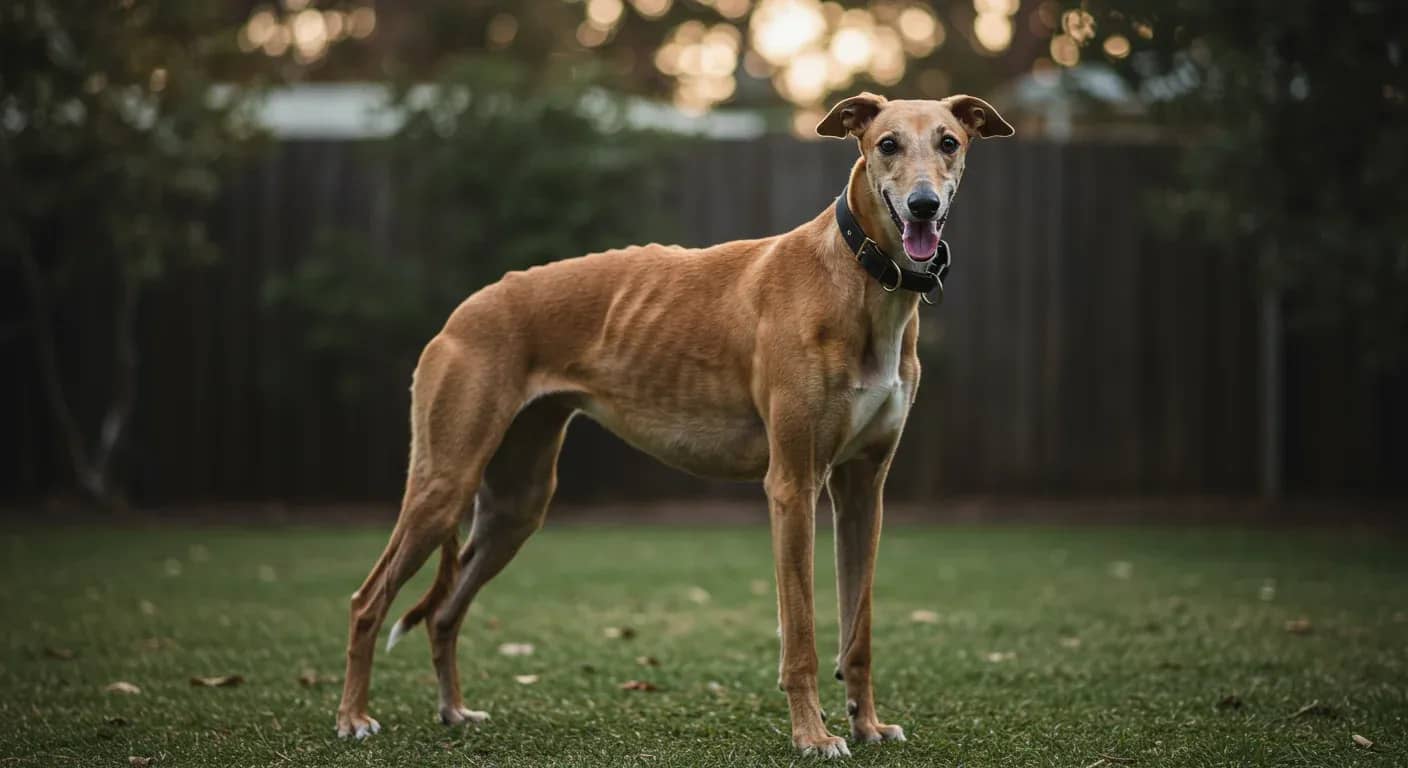At a glance
- Whippets need 25-30% protein from named animal sources to support their lean, athletic build
- Moderate fat content (12-18%) provides sustained energy for their high metabolism without weight gain
- Many Whippets show sensitivities to grains, making limited ingredient diets worth considering
- Both wet and dry foods work well, though wet food helps with hydration in this active breed
Understanding your Whippet's unique nutritional profile
You might notice that your Whippet seems to burn through energy differently than other dogs. Their lean, muscular build and bursts of intense activity create specific dietary needs that differ significantly from bulkier or less active breeds. These dogs require careful nutritional balance to maintain their ideal weight whilst supporting their athletic lifestyle.
Research shows that Whippets have faster metabolisms than many breeds, yet they're also prone to weight gain during less active periods. This creates a unique challenge for owners who need to provide enough nutrition for energy bursts without overfeeding during rest periods.
The breed's sensitivity extends beyond just calorie needs. Many owners report that their dogs show digestive sensitivities to certain ingredients, particularly grains and artificial additives. Understanding these characteristics helps explain why generic dog food formulas often don't work optimally for this breed.
Protein requirements for lean muscle maintenance

When it comes to protein in Whippet nutrition, quality matters more than quantity alone. These dogs need 25-30% protein content in their dry food, with adult dogs typically thriving at the lower end of this range and puppies requiring up to 32% for proper growth and development.
The first ingredient should always be a named animal protein such as chicken, turkey, lamb, or fish. Research tells us that animal-based proteins provide the complete amino acid profile that supports muscle maintenance and repair in athletic breeds. Plant-based proteins, whilst not harmful, don't offer the same biological value for muscle development.
Many Whippets show excellent results on foods where meat, fish, or poultry makes up the first two or three ingredients. This approach ensures they're getting concentrated, easily digestible protein rather than protein that's diluted with fillers or plant matter.
Managing fat content for sustained energy
Have you wondered why your dog seems to have incredible bursts of energy followed by long rest periods? This natural pattern influences their fat requirements significantly. Whippets benefit from moderate fat levels between 12-18% in dry food, providing sustained energy without promoting weight gain during inactive periods.
Omega-3 and omega-6 fatty acids from sources like fish oil, flaxseed, or chicken fat support more than just energy needs. These healthy fats maintain coat condition, reduce inflammation from exercise, and support overall skin health. Many owners notice improved coat shine and reduced skin sensitivity within 4-6 weeks of switching to foods with quality fat sources.
The key is avoiding foods with excessive fat content, which can lead to digestive upset or unwanted weight gain. These dogs don't need the high-fat formulas designed for working breeds that maintain constant activity levels.
Choosing the right food format
Many Whippet owners worry about whether dry kibble provides enough moisture for their active dogs. Both wet and dry foods can work well, though each offers distinct advantages depending on your dog's specific needs and your lifestyle preferences.
Dry kibble offers convenience and helps maintain dental health through the chewing action. Quality kibble provides balanced nutrition and typically costs less per serving than wet alternatives. However, it contains less moisture, which can be a consideration for dogs that don't drink water readily after exercise.
Wet food contains significantly more moisture, making it beneficial for hydration and often more appealing to picky eaters. The higher moisture content can aid digestion and may help dogs feel satisfied with smaller portions. Some owners find success mixing wet and dry foods to balance convenience with hydration benefits.
Raw diets have gained popularity among Whippet owners, with proponents noting improvements in coat condition and energy levels. However, raw feeding requires careful preparation and veterinary guidance to ensure nutritional balance and food safety.
Addressing common dietary sensitivities

Sometimes the reasons for digestive upset are ingredient-related rather than portion-related. Research indicates that grain sensitivities affect a notable percentage of the breed, with symptoms including digestive upset, skin irritation, or ear infections developing over time.
Grain-free formulas using sweet potatoes, peas, or other easily digestible carbohydrates often resolve these issues within 2-3 weeks of switching. Limited ingredient diets can help identify specific triggers if multiple sensitivities are suspected.
When introducing any new food, gradual transition over 7-10 days prevents digestive upset. Start by mixing 25% new food with 75% current food for the first few days, then gradually increase the new food proportion. Most dogs adapt well to this approach, though some may need slower transitions.
Recommended brands and selection criteria
Several brands consistently receive positive feedback from Whippet owners and meet the nutritional criteria these dogs require. Scrumbles offers grain-free options with high meat content and added prebiotics for digestive support. Orijen and Acana provide high-protein, biologically appropriate formulas with quality ingredient sourcing.
For raw feeding enthusiasts, ProDog Raw offers balanced combinations of meat, bone, offal, and plant ingredients specifically formulated for different life stages. These complete raw meals eliminate the guesswork involved in home preparation whilst maintaining the benefits raw feeders seek.
When evaluating any food, look beyond marketing claims to examine the ingredient list and guaranteed analysis. Quality foods typically cost between $2-4 per pound, reflecting the higher cost of premium protein sources and the absence of cheap fillers.
- First ingredient should be named animal protein
- Avoid foods with artificial colours, flavours, or preservatives
- Consider grain-free options if sensitivities are suspected
Practical feeding guidelines and troubleshooting
Portion control becomes crucial with this breed's tendency toward both underweight and overweight conditions. Adult dogs typically thrive on two meals daily, whilst puppies need three to four smaller meals until 5-6 months of age. Use your dog's body condition rather than just weight to determine appropriate portions.
Picky eating sometimes develops in these dogs, particularly if they've been overfed treats or table scraps. Offering different textures or flavours can help, though consistency in meal timing and removing uneaten food after 20 minutes often resolves selective eating within a week or two.
Monitor for signs that indicate veterinary consultation: persistent diarrhea lasting more than 24 hours, vomiting, unexplained weight loss, or skin issues that don't resolve with dietary changes. These symptoms may indicate underlying health issues rather than simple food sensitivities.
Regular body condition assessment helps maintain optimal weight throughout your dog's life. You should be able to feel the ribs easily without pressing hard, and there should be a visible waist when viewed from above. Adjust portions based on activity level, age, and seasonal changes in exercise patterns.



